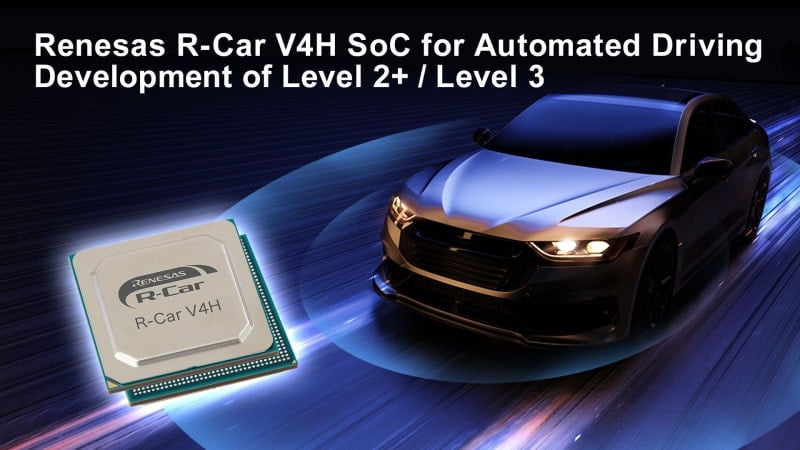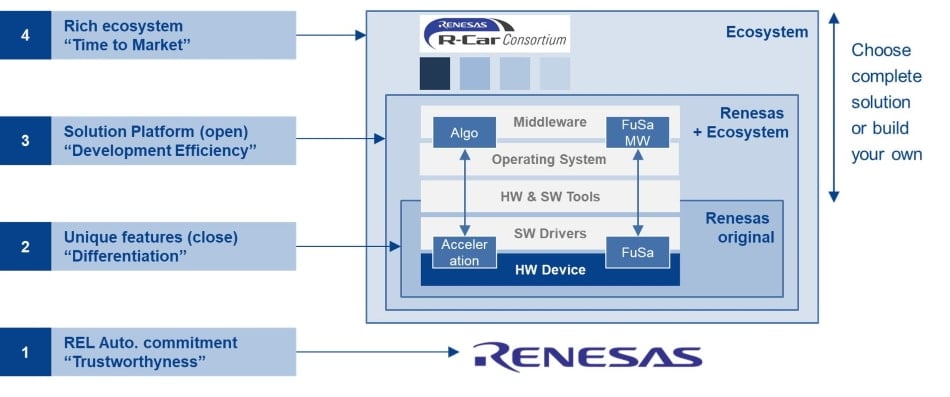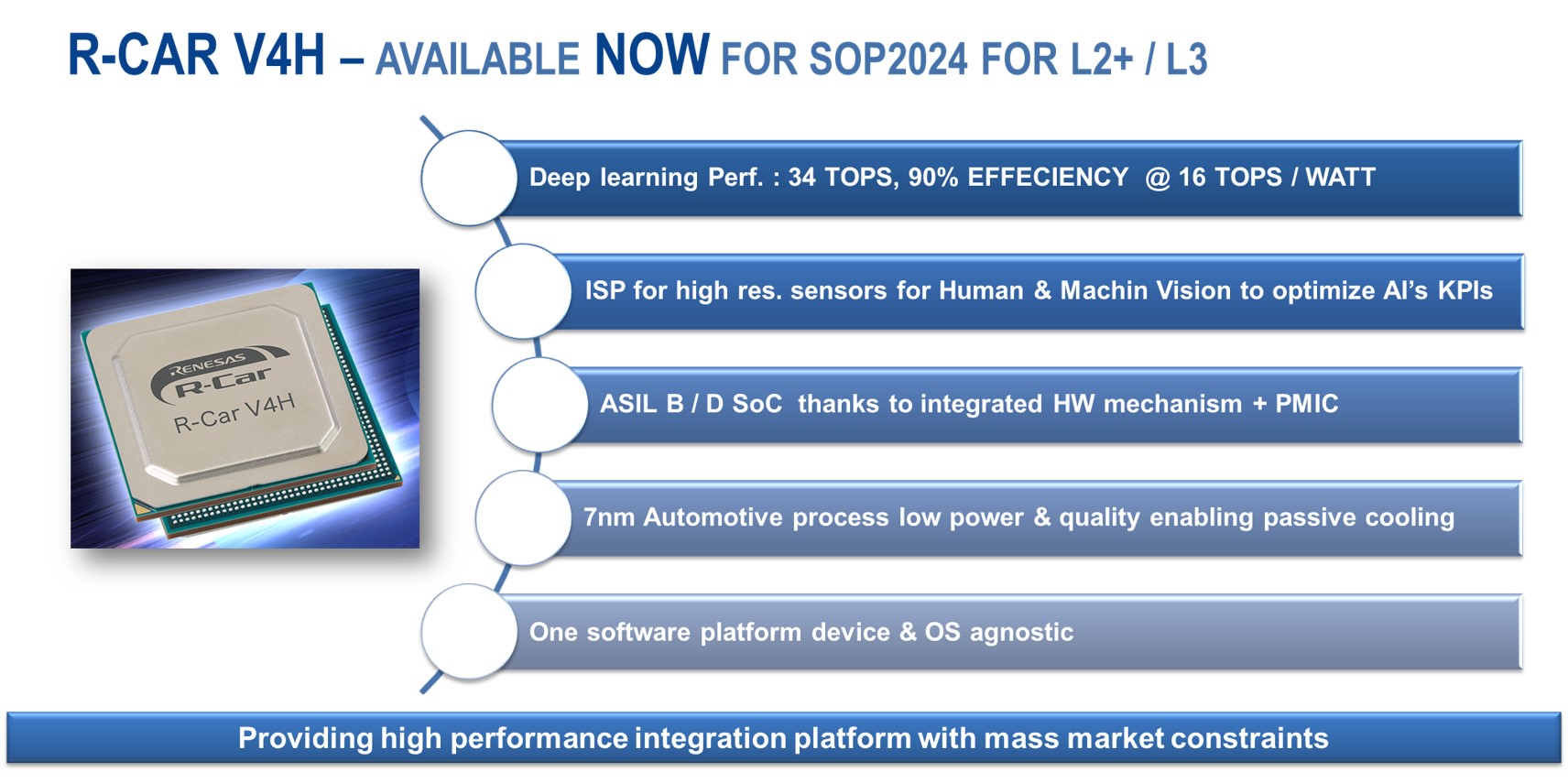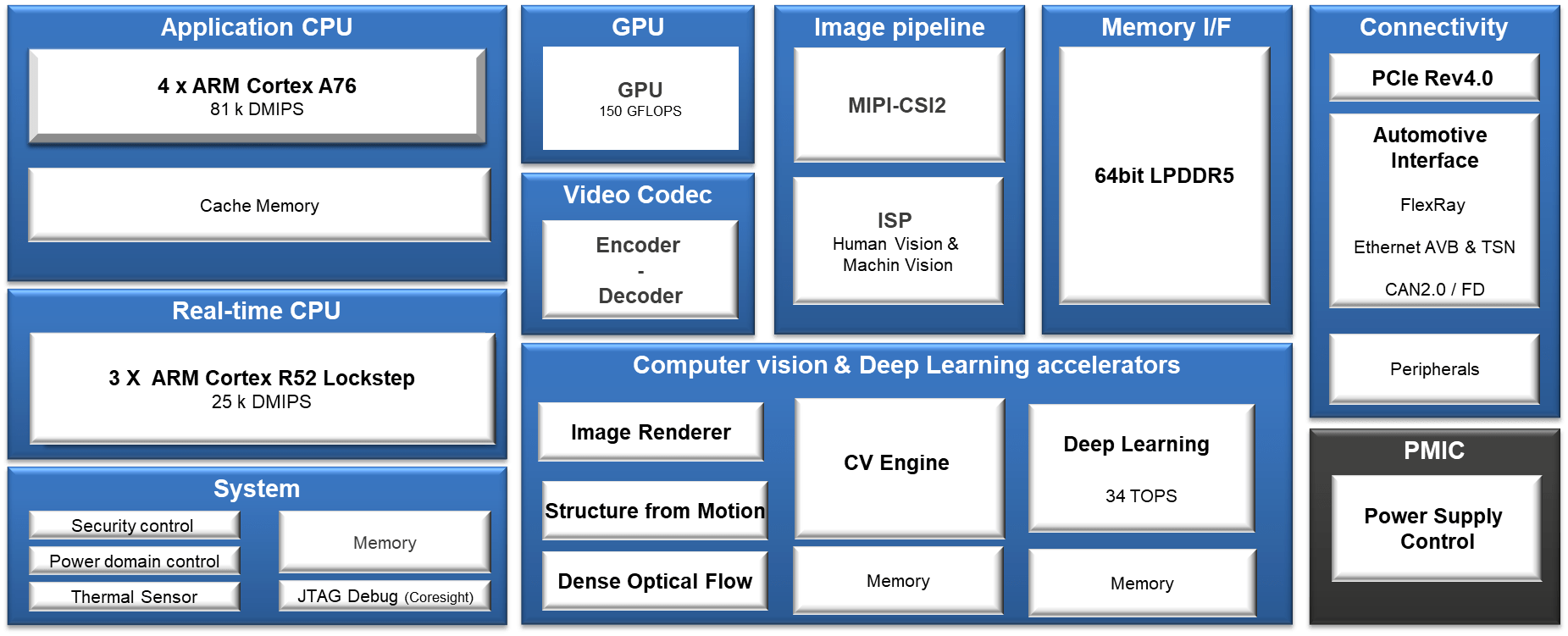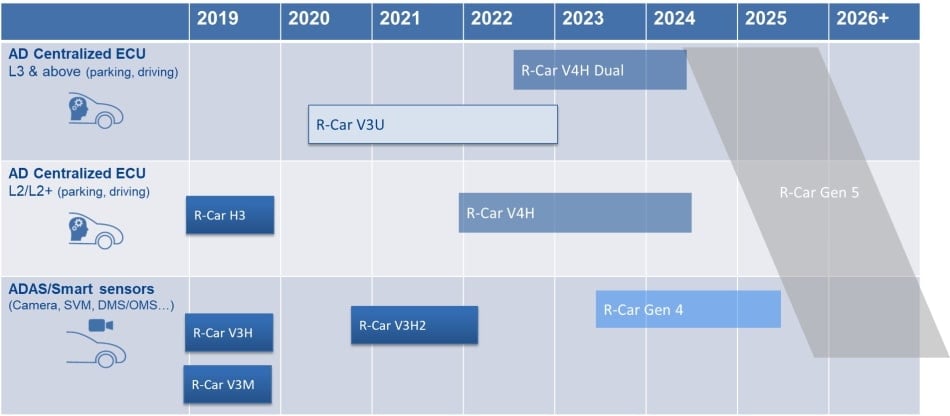Overview
Description
Addressing volume zone of automotive driving Level 2+ / Level 3
The R-Car V4H system-on-chip is tailored for central processing for advanced driver-assistance (ADAS) and automated driving (AD) systems. The R-Car V4H achieves deep learning performance of up to 34 TOPS (Tera Operations Per Second), enabling high-speed image recognition and processing of surrounding objects by automotive cameras, radar, and Light Detection and Ranging (LiDAR).
Thanks to a high level of integration, the R-Car V4H allows manufacturers to develop cost-competitive, single-chip, ADAS electric control units (ECUs). These control units may support driving systems appropriate for automated driving Levels 2+ and Level 3, including full NCAP 2025 features. A dual V4H configuration enables seamless system performance improvements and fail-degraded operational support which is required for Level 3 systems. The R-Car V4H also supports surround view and automatic parking functions with impressive 3D visualization effects such as very realistic views.
In addition to R-Car V4H, discover our next cost-competitive product lineup (V4M) here.
R-Car V3M and R-Car V3H, both currently in high-volume production, focus on smart front cameras for Level 1 and Level 2 applications. R-Car V4H uses a scalable architecture that allows the re-use of software assets from the third generation of R-Car devices. This enables customers to expand to next-generation systems smoothly and quickly as they develop Level 2+ and Level 3 systems. The R-Car V4H also supports the latest LiDAR, radar, and thermal camera technologies.
State-of-the-art R-Car deep learning technology at low power consumption: 16 TOPS/Watt
The R-Car V4H offers up to 34 TOPS of highly efficient deep learning performance. It uses ultra-low power consumption and requires only passive air-cooling, both of which help reduce the total bill of materials (BOM).
Solution supports the industry’s stringent ASIL B/D requirements
The R-Car V4H development process targets ASIL D systematic capability for all safety-relevant IP. The signal processing portion of the R-Car V4H is expected to achieve ASIL B and D metrics for the real-time domain. Furthermore, the R-Car V4H can be used in combination with the RAA271041 pre-regulator and the RAA271005 PMIC optimized for cars. This enables a highly reliable power supply for the R-Car V4H and peripheral memories from the 12V supply of the vehicle battery. These features enable low-power operation while targeting ASIL D compliance for systematic and random hardware faults at a very low BOM cost. This helps to minimize the effort of hardware and software development while reducing design complexity, cost, and time to market. Superior scalability maximizes software re-use to cover ADAS/AD Level 1 to Level 3.
Embedded software platform development paving the way toward the software-defined car
An R-Car V4H Software Development Kit (SDK) is also available to perform faster and easier initial device evaluation and software development including deep learning. The SDK offers full functionality for machine learning development, and optimization of embedded systems for performance, power efficiency, and functional safety. Complete simulation models are available, and the Renesas operating system agnostic software platform enables easier development of the software-defined car.
Features
- Four Arm® Cortex®-A76 cores at 1.8GHz for a total of 81kDMIPS of general compute for ADAS/AD applications
- Three lockstep Arm® Cortex®-R52 cores at 1.4GHz, for a total of 25kDMIPS to support ASIL D real-time operation, and eliminate the need for external microcontrollers
- Dedicated Deep Learning and Computer Vision I/Ps with overall performance of 34 TOPS
- Image Signal Processor (ISP) with parallel processing for machine and human vision
- Image Renderer (IMR) for fisheye distortion correction or other mathematical operations
- Graphics Processing Unit (GPU) AXM-8-256 at 600MHz for a total of more than 150 GFLOPS
- Dedicated automotive Interfaces: CAN, Ethernet AVB, TSN, and FlexRay
- Two fourth-generation PCIe interfaces
- Integrates multiple safety mechanisms that provide high coverage with fast detection and response for random hardware faults, achieving ASIL B/D metrics for the majority of the SoC processing chain.
- Open solution supported by Renesas and R-Car Consortium partners
Comparison
Applications
Design & Development
Software & Tools
Boards & Kits
Models
ECAD Models
Schematic symbols, PCB footprints, and 3D CAD models from SamacSys can be found by clicking on the CAD Model links in the Product Options table. If a symbol or model isn't available, it can be requested directly from SamacSys.

Support

Support Communities
Support Communities
-
How can I purchase the R-Car V4H System Evaluation Board Set/White Hawk?(RTP8A779G0ASKB0FS0SA000)
Unlike other MCU products, there is no option to purchase on the product page. (RTP8A779G0ASKB0FS0SA000)
Apr 9, 2025 -
R-Car V4H White Hawk
Hello team, Maximum how many cameras can be connected to R-Car V4H White Hawk? I have been through the manual and it mentions only 2 CSI interfaces. I also want to know if any other type of camera connectivity (USB, LAN) can be possible. Regards Prabrit
Jan 24, 2025 -
Running dsp_sample application and deploy pre-built network on R-Car V4H Board
I am trying to run dsp_sample application on the board, and I have deploy a pre-built model on board. Aanyone can help me with this is whether the sample application for dsp usage can be run on the target board without the CEVA CDNN packages. Also what the ...
Sep 4, 2024
Videos & Training
Introduction and guide on displaying trace data for each process and its time period within the specified capture address range in the "ETM Call Flow Trace" of e² studio for R-Car.
